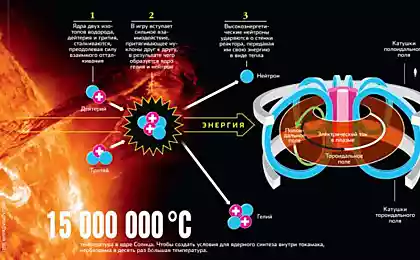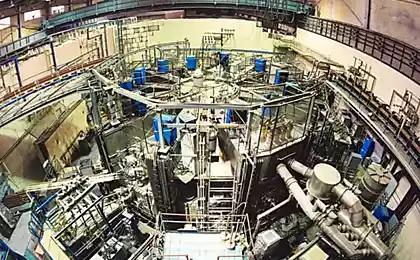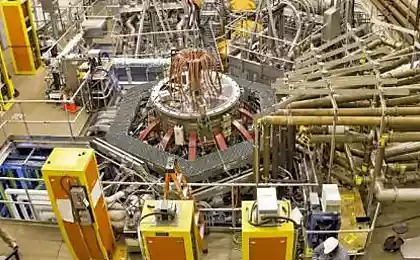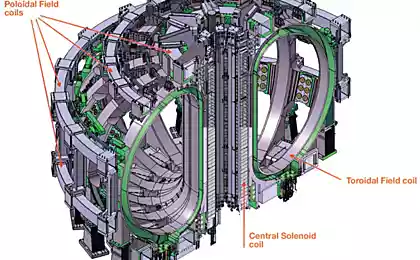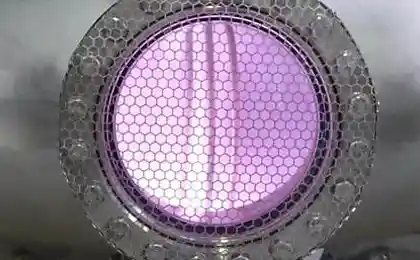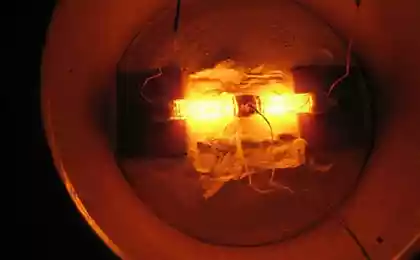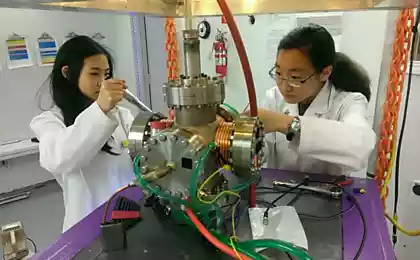515
Fusion reactor tokamak Alcator C-Mod sets world record
Scientists and engineers of the Center for the study of plasma and nuclear fusion Massachusetts Institute of technology made a step forward in the pursuit of clean energy. The team set a new world record for the pressure of the plasma in a fusion reactor tokamak Alcator C-Mod. The plasma pressure is a key element for energy production in the process of thermonuclear fusion and for the first time a new result MIT has reached more than 2 atmospheres. The leader and senior scientist, Alcator Earl Marmar will present the report of the International atomic and thermonuclear energy at the conference on 17 October in Kyoto, Japan.

Thermonuclear fusion has the potential to produce virtually unlimited supplies of clean, safe, obesplozhennym energy. The synthesis is the same process that powers the sun, it can be implemented in reactors simulating the conditions of super hot miniature “stars” of the plasma (superheated gas) contained in a magnetic field. For over 50 years it was known that to ensure the viability of the synthesis on the Earth's surface, the plasma must be very hot (more than 50 million degrees), it must be stable under strong pressure and kept in a fixed volume.
Successful synthesis also requires that the product as the product of three factors (density of plasma particles, the holding time and temperature) has reached a certain value. Above this value (so-called “triple product”), the energy released in the reactor is greater than the energy needed to continue reaction.
The pressure, which is the product of density and temperature, is about two-thirds of this problem. The quantity of energy produced increases with the square of pressure, so doubling the pressure results in a fourfold increase in energy production.

For 23 years, Alcator C-Mod is operated by the Massachusetts Institute of technology, record the pressure of the plasma in the magnetic confinement device is repeatedly achieved. The previous record of 1.77 ATM was installed in 2005 (also in Alcator C-Mod). Setting a new record of 2.05 atmospheres, the result has been improved by 15 percent, the temperature inside the Alcator C-Mod has reached more than 35 million degrees Celsius, at least two times higher than the temperature at the center of the Sun.
The plasma produced 300 trillion fusion reactions per second and the strength of the Central magnetic field has reached 5.7 Tesla. This resulted in the formation of 1.4 million amperes of electric current and heating them to more than 4 million watts. The reaction occurred in a volume of about 1 cubic metre (not much more than a dressing room) and the plasma was continued for two full seconds.
Other experiments on nuclear fusion conducted in reactors like Alcator reached those temperatures but at pressures closer to 1 atmosphere; the results of MIT exceeded the highest pressure achieved in the non-Alcator devices by about 70 percent.
While the contribution of the Alcator C-Mod to facilitate the development of nuclear energy was significant, it remained a research object. In 2012, the Department of energy has decided to stop funding Alcator due to pressure from the budget for the construction of ITER. After this decision, Congress restored funding for Alcator C-Mod for a three-year period, which ended September 30.
“This is a remarkable achievement which underlines the highly successful program Alcator C-Mod at mit,” says Dale Meade, former Deputy Director of the plasma physics Lab of Princeton University, who was not directly involved in the experiments. “A record plasma pressure confirms that the approach of the high magnetic field is an attractive path to practical fusion energy”.
“This result confirms that the high pressure required for combustion of the plasma can best be achieved through such vysokorazvityh of totmakov as Alcator C-Mod,” says Riccardo Betti, Robert L. Mccrory, Professor of engineering mechanics, physics and astronomy at the University of Rochester.
SUBSCRIBE to OUR youtube channel that allows you to watch online, download from YouTube free video about the recovery, the rejuvenation of man. Love for others and ourselves, as the feeling of high vibrations — an important factor for improvement .
Put LIKES and share with your FRIENDS!
www.youtube.com/channel/UCXd71u0w04qcwk32c8kY2BA/videos
Alcator C - Mod is the world's only compact nuclear fusion reactor, high magnetic field with an enhanced form of design called a tokamak (a transliteration of the Russian words "toroidal chamber"), which limits super-hot plasma in the chamber a toroidal shape. High-intensity magnetic field C-Mod (8 Tesla, or 160 000 Earth's magnetic field) allows the device to create a dense, hot plasma and to maintain their stability for more than 80 million degrees. Its magnetic field more than twice that typically used in other designs, which increases its ability to contain a plasma pressure of 4 times.
C-Mod is the third largest tokamak a strong magnetic field, its construction and operation in MIT for the first time was made Professor of physics at the Massachusetts Institute of technology Bruno Coppi. Professor of electrical engineering and computer science Ron Parker headed the design stage. Professor Ian Hutchinson from the Department of nuclear science and technology headed by its construction and first 10 years of operation until 2003.
Although a new device is announced and built, recently set a record of pressure in C-Mod is likely to last for the next 15 years. The ITER tokamak currently under construction in France, will be approximately 800 times greater in volume than the Alcator C-Mod, but it will operate at a lower magnetic field. According to a recent report of the Ministry of energy, it is expected that operation at full power ITER will reach 2.6 atmospheres by 2032.
Alcator C-Mod similar in size and cost nondatabase thermonuclear fusion with magnetic confinement of plasma developed by a private company, nuclear fusion, although this setting can reach up to 50 times more pressure.
“Compact tokamaks with strong field provide another exciting opportunity to accelerate the development of fusion energy, so that in a short time, positive changes in the issue of climate change and the future of clean energy is possible — I believe that we all share these goals,” says Dennis Wyatt, Professor of engineering Hitachi America, Director of the Center for the study of plasma and thermonuclear synthesis and the head of the Department of nuclear science and engineering Massachusetts Institute of technology.
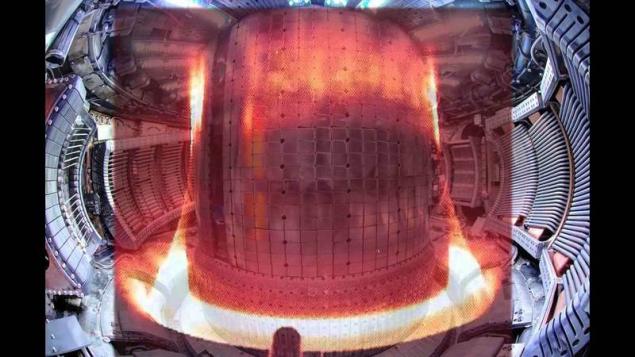
These experiments were planned and carried out in the last day of Alcator C-Mod team MIT and staff from other laboratories in the USA, including Laboratory plasma physics at Princeton University, oak oak ridge national laboratory and General Atomics. The object of the Alcator C-Mod, which is September 30, was officially closed after 23 years of work leaves a huge legacy of cooperation. Alcator C-Mod contributed to the writing of more than 150 master's theses and conduct dozens of inter-organizational research projects.
In order to understand how the design principles Alcator C-Mod can be applied to power generation, a team of MIT on the issues of synthesis is working on the adaptation of new available high-temperature superconductors high field, which will be capable of producing a magnetic field of greater strength without the consumption of electricity or heat.These superconductors are the Central component of the conceptual pilot facility called Affordable Robust, Compact (ARC) reactor, which can produce up to 250 million watts of electricity. published
Source: phys.org/news/2016-10-alcator-c-mod-tokamak-nuclear-fusion.html

Thermonuclear fusion has the potential to produce virtually unlimited supplies of clean, safe, obesplozhennym energy. The synthesis is the same process that powers the sun, it can be implemented in reactors simulating the conditions of super hot miniature “stars” of the plasma (superheated gas) contained in a magnetic field. For over 50 years it was known that to ensure the viability of the synthesis on the Earth's surface, the plasma must be very hot (more than 50 million degrees), it must be stable under strong pressure and kept in a fixed volume.
Successful synthesis also requires that the product as the product of three factors (density of plasma particles, the holding time and temperature) has reached a certain value. Above this value (so-called “triple product”), the energy released in the reactor is greater than the energy needed to continue reaction.
The pressure, which is the product of density and temperature, is about two-thirds of this problem. The quantity of energy produced increases with the square of pressure, so doubling the pressure results in a fourfold increase in energy production.

For 23 years, Alcator C-Mod is operated by the Massachusetts Institute of technology, record the pressure of the plasma in the magnetic confinement device is repeatedly achieved. The previous record of 1.77 ATM was installed in 2005 (also in Alcator C-Mod). Setting a new record of 2.05 atmospheres, the result has been improved by 15 percent, the temperature inside the Alcator C-Mod has reached more than 35 million degrees Celsius, at least two times higher than the temperature at the center of the Sun.
The plasma produced 300 trillion fusion reactions per second and the strength of the Central magnetic field has reached 5.7 Tesla. This resulted in the formation of 1.4 million amperes of electric current and heating them to more than 4 million watts. The reaction occurred in a volume of about 1 cubic metre (not much more than a dressing room) and the plasma was continued for two full seconds.
Other experiments on nuclear fusion conducted in reactors like Alcator reached those temperatures but at pressures closer to 1 atmosphere; the results of MIT exceeded the highest pressure achieved in the non-Alcator devices by about 70 percent.
While the contribution of the Alcator C-Mod to facilitate the development of nuclear energy was significant, it remained a research object. In 2012, the Department of energy has decided to stop funding Alcator due to pressure from the budget for the construction of ITER. After this decision, Congress restored funding for Alcator C-Mod for a three-year period, which ended September 30.
“This is a remarkable achievement which underlines the highly successful program Alcator C-Mod at mit,” says Dale Meade, former Deputy Director of the plasma physics Lab of Princeton University, who was not directly involved in the experiments. “A record plasma pressure confirms that the approach of the high magnetic field is an attractive path to practical fusion energy”.
“This result confirms that the high pressure required for combustion of the plasma can best be achieved through such vysokorazvityh of totmakov as Alcator C-Mod,” says Riccardo Betti, Robert L. Mccrory, Professor of engineering mechanics, physics and astronomy at the University of Rochester.
SUBSCRIBE to OUR youtube channel that allows you to watch online, download from YouTube free video about the recovery, the rejuvenation of man. Love for others and ourselves, as the feeling of high vibrations — an important factor for improvement .
Put LIKES and share with your FRIENDS!
www.youtube.com/channel/UCXd71u0w04qcwk32c8kY2BA/videos
Alcator C - Mod is the world's only compact nuclear fusion reactor, high magnetic field with an enhanced form of design called a tokamak (a transliteration of the Russian words "toroidal chamber"), which limits super-hot plasma in the chamber a toroidal shape. High-intensity magnetic field C-Mod (8 Tesla, or 160 000 Earth's magnetic field) allows the device to create a dense, hot plasma and to maintain their stability for more than 80 million degrees. Its magnetic field more than twice that typically used in other designs, which increases its ability to contain a plasma pressure of 4 times.
C-Mod is the third largest tokamak a strong magnetic field, its construction and operation in MIT for the first time was made Professor of physics at the Massachusetts Institute of technology Bruno Coppi. Professor of electrical engineering and computer science Ron Parker headed the design stage. Professor Ian Hutchinson from the Department of nuclear science and technology headed by its construction and first 10 years of operation until 2003.
Although a new device is announced and built, recently set a record of pressure in C-Mod is likely to last for the next 15 years. The ITER tokamak currently under construction in France, will be approximately 800 times greater in volume than the Alcator C-Mod, but it will operate at a lower magnetic field. According to a recent report of the Ministry of energy, it is expected that operation at full power ITER will reach 2.6 atmospheres by 2032.
Alcator C-Mod similar in size and cost nondatabase thermonuclear fusion with magnetic confinement of plasma developed by a private company, nuclear fusion, although this setting can reach up to 50 times more pressure.
“Compact tokamaks with strong field provide another exciting opportunity to accelerate the development of fusion energy, so that in a short time, positive changes in the issue of climate change and the future of clean energy is possible — I believe that we all share these goals,” says Dennis Wyatt, Professor of engineering Hitachi America, Director of the Center for the study of plasma and thermonuclear synthesis and the head of the Department of nuclear science and engineering Massachusetts Institute of technology.

These experiments were planned and carried out in the last day of Alcator C-Mod team MIT and staff from other laboratories in the USA, including Laboratory plasma physics at Princeton University, oak oak ridge national laboratory and General Atomics. The object of the Alcator C-Mod, which is September 30, was officially closed after 23 years of work leaves a huge legacy of cooperation. Alcator C-Mod contributed to the writing of more than 150 master's theses and conduct dozens of inter-organizational research projects.
In order to understand how the design principles Alcator C-Mod can be applied to power generation, a team of MIT on the issues of synthesis is working on the adaptation of new available high-temperature superconductors high field, which will be capable of producing a magnetic field of greater strength without the consumption of electricity or heat.These superconductors are the Central component of the conceptual pilot facility called Affordable Robust, Compact (ARC) reactor, which can produce up to 250 million watts of electricity. published
Source: phys.org/news/2016-10-alcator-c-mod-tokamak-nuclear-fusion.html

